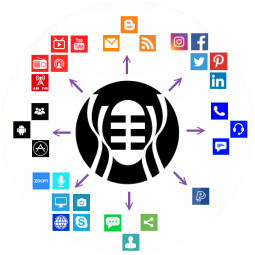Radio Toni Everyday Business Tackling Trauma with Tracey and Toni, November 11, 2020
Radio Toni Everyday Business tackling Trauma with Tracey Horton and Toni Lontis
Intro to Tracey and her bio - Tracey Horton is an International award-winning speaker, author, and qualified life coach. She has worked alongside men and women for over 25 years helping to rebuild lives and allowing people to become the best versions of themselves. She has spent years helping people to create their own authentic journey.
Tracey knows what real brokenness is and she has managed to build her life from that of an alcoholic, abused, poverty-stricken child to where she is today…a passionate, warm, caring and amazing woman. Her experiences have given her insight and wisdom that are today being used to help people create the life they could only dream of.
Through books, seminars, retreats and life coaching, Tracey has a way of equipping people to practically reach their goal and live their life to their fullest potential.\
Please welcome Tracey Horton.
RECAP What is Trauma?
Trauma is an emotional response to a terrible event like an accident, rape or natural disaster. Immediately after the event, shock and denial are typical. Longer term reactions include unpredictable emotions, flashbacks, strained relationships and even physical symptoms like headaches or nausea.
Why we talk about this – because all the research shows that not dealing leads to life long physical and mental health issues – the body keeps a score – health and longevity – heal your trauma
Last week we spoke about micro traumas and the everyday events that impact on our lives when we have experienced trauma and are part way through our healing, or indeed healed. We talked about complex trauma.
This week we want to talk about trauma and triggers.
Start with a story from Tracey.
A trigger in psychology is a stimulus such as a smell, sound, or sight that triggers feelings of trauma. A trigger is a reminder of a past trauma. A flashback is a vivid, often negative memory that may appear without warning. It can cause someone to lose track of their surroundings and “relive” a traumatic event.
Triggers can take many forms. They may be a physical location or the anniversary of the traumatic event. A person could also be triggered by internal processes such as stress.
Sometimes triggers are predictable. For instance, a veteran may have flashbacks while watching a violent movie. In other cases, triggers are less intuitive. A person who smelled incense during a sexual assault may have a panic attack when they smell the same incense in a store.
Some people use “trigger” in the context of other mental health concerns, such as substance abuse or anxiety. In these cases, a trigger can be a cue that prompts an increase in symptoms. For example, a person recovering from anorexia may be triggered by photos of very thin celebrities. When the person sees these photos, they may feel the urge to starve themselves again.
According to Wiki a trigger can be anything that provokes fear or distressing memories in the affected person, and which the affected person associates with a traumatic experience. Some common triggers are:
-
certain times of day – for example, sunset or sunrise[1]
-
certain times of year or specific dates – for example, autumn weather that resembles the affected person's experience of the weather during the September 11 attacks, or the anniversary of a traumatic experience
-
sights – for example, a fallen tree or a light shining at a particular angle
-
places]– for example, a bathroom, or all bathrooms
-
a person, especially a person who was present during a traumatic event or resembles someone involved in that event in some respect
-
an argument
-
a particular odor – such as freshly mown grass, the fragrance of an aftershave product, or perfume
-
a particular taste[6] – such as the food eaten during or shortly before a traumatic experience
-
a particular sound[7][9] – such as a helicopter or a song[1]
-
a particular texture[1][10]
-
a sensation on the skin[6] – such as the feeling of a wristwatch resembling the feeling of handcuffs, or sexual touching for victims of sexual assault[6]
-
the position of the body[12]
-
physical pain[6][12]
-
emotions – such as feeling overwhelmed, vulnerable, or not in control[1][10]
-
a particular situation – for example, being in a crowded place[1]
HOW ARE TRIGGERS FORMED?
The exact brain functioning behind triggers is not fully understood. However, there are several theories about how triggers work.
When a person is in a threatening situation, they may engage in a fight or flight response. The body goes on high alert, prioritizing all its resources to react to the situation. Functions that aren’t necessary for survival, such as digestion, are put on hold.
One of the functions neglected during a fight or flight situation is short-term memory formation. In some cases, a person’s brain may misfile the traumatic event in its memory storage. Rather than being stored as a past event, the situation is labeled as a still-present threat. When a person is reminded of the trauma, their body acts as if the event is happening, returning to fight or flight mode.
In some cases, a sensory trigger can cause an emotional reaction before a person realizes why they are upset.Another theory is that triggers are powerful because they often involve the senses. Sensory information (sights, sounds, and especially smells) plays a large part in memory. The more sensory information is stored, the easier a memory is to recall.
During a traumatic event, the brain often ingrains sensory stimuli into memory. Even when a person encounters the same stimuli in another context, they associate the triggers with the trauma. In some cases, a sensory trigger can cause an emotional reaction before a person realizes why they are upset.
Habit formation also plays a strong role in triggering. People tend to do the same things in the same way. Following the same patterns saves the brain from having to make decisions.
For example, say a person always smokes while they are driving. When a person gets in the car, their brain expects them to follow the same routine and light a cigarette. Thus, driving could trigger the urge to smoke, even if the person wishes to quit smoking. Someone can be triggered even if they don’t make a conscious connection between their behavior and their surroundings.
WHAT ARE TRIGGER WARNINGS?
A trigger warning is a notice of potential triggers in future discussion or content. The aim is to let people with mental health concerns avoid or prepare themselves for triggers. It is impossible to predict or avoid all triggers, since many are unique to a person’s situation. Warnings are often reserved for common triggers such as images of violence.
Recently, many students have requested trigger warnings in school. There has been much public debate over whether this practice is appropriate for classrooms.
Opponents of trigger warnings often argue these warnings cater to overly sensitive students. Some claim trigger warnings promote censorship. Others believe they infringe upon teachers’ ability to teach course material.
Advocates often argue trigger warnings are necessary for equal access to education. Triggers can cause flashbacks and panic attacks which disrupt learning. According to the American Psychological Association (APA), triggers are often more distressing if they come as a surprise. Advocates say trigger warnings allow students with posttraumatic stress to feel safe in class.
If a student says they have PTSD, personalized trigger warnings are appropriate.There is little research on the effectiveness of classroom trigger warnings. The APA says specific triggers can be hard to predict. Thus, generic warnings on classroom content may be less effective. If a student says they have PTSD, personalized trigger warnings are appropriate.
The Americans with Disabilities Act (ADA) and the Individuals with Disabilities in Education Act (IDEA) forbid discrimination against people with disabilities. These laws include mental health disabilities such as PTSD. Federal law requires educators to make reasonable accommodations to such individuals.
Federal law does not specifically address trigger warnings. Yet the APA suggests trigger warnings may count as accommodations in some cases. Deliberately triggering a person with PTSD could be a form of discrimination.
GETTING HELP FOR TRIGGERS
Trigger warnings are useful in some cases. But avoiding one’s triggers will not treat the underlying mental health concerns. If triggers interfere with someone’s daily life, the person may wish to see a therapist.
In therapy, people can process the emotions concerning their pasts. Some may learn relaxation techniques to cope with panic attacks. Others may learn how to avoid unhealthy behaviors. With time and work, a person can face their triggers with much less distress.
Daily challenge: COPE-ing with triggers
The COPE strategy can be used for triggers, intrusive thoughts, or sudden anxiety. C is for cleansing breath. This is a deep breath in through the nose and exhale out of the mouth with a sigh. This will help initiate the inhibitory, or parasympathetic system, to help calm the nervous system. O is for observation—scan the environment, make sure there is no imminent danger. P is for positive self-talk such as, “I am ok, I am safe, I am breathing, this will pass.” E is for explanation, “This was only a trigger. It will peak and subside … the stress will flow through me like water flows through a hose.” Continue to do slow deep breathing until the stress reaction subsides.
Practice COPE to manage triggers as they arise. You may also want to try aromatherapy such as lavender or eucalyptus oil to quickly reduce a stress response. The smell goes to the olfactory nerve which is located in the mid-brain which processes triggers. The beauty of this is that smell by-passes the frontal lobe or verbal thinking part of the brain and works directly on the emotional sensory level.
Suggestion: Write COPE on an index card to keep it with you. Also, since aroma oils can leak, it works to find a travel size quality soap that you can smell and use to calm your nervous system when moving about your day.
Triggers worksheet
Radio Toni Everyday Business Tackling Trauma with Tracey and Toni

Radio Toni Everyday Business tackling Trauma with Tracey Horton and Toni Lontis
Tracey Horton has a story to tell, one of brokenness and victory, a confronting story but only by virtue of what she has endured.
Tracey Horton is the author of, The Unhappy Smile, Keys to Gaining the Authentic Life That Is All Yours









